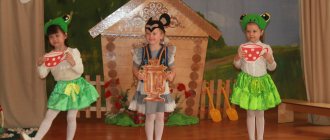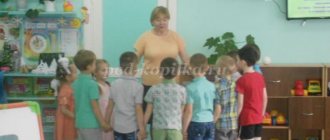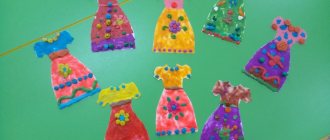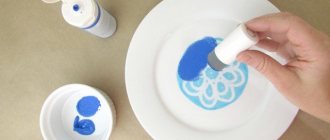Abstract of GCD in the senior group “What do we know about water, they say it’s everywhere”
Description of material:
I bring to your attention a summary of the educational activity on familiarization with the outside world with elements of experimentation for children of the older group on the topic: “What do we know about water, they say it is everywhere.” This material will be useful to teachers of the senior group. This is a summary of an educational and research lesson aimed at expanding children's knowledge about water and developing curiosity in preschoolers.
Integration of educational areas:
“Cognition”, “Communication”, “Socialization”, “Cognitive-research”, “Reading fiction”, “Productive”.
Target:
generalize children's knowledge about water.
Tasks:
Educational:
Expand children's understanding of the properties of water, the importance of water in the life of animals, plants and humans, and its role in nature. Teach children to conduct simple experiments with water. To give children an understanding of why water sometimes needs purification and to give a basic understanding of the filtration process.
Educational:
Develop thinking, attention, memory, ability to analyze and observe. Develop skills in conducting laboratory experiments and curiosity.
Speech:
Develop coherent speech, enrich children's vocabulary: evaporation, filters, filtration, wastewater treatment plants, the water cycle in nature.
Educational:
To instill in children a careful attitude towards water, to develop skills in everyday environmental behavior in relation to water supplies.
Demo material:
illustrations depicting the planet’s water resources (rivers, lakes, seas, oceans); demonstration poster “Water cycle in nature”; box “with a riddle (piece of ice)”; a pre-cut balsam sprig in a glass of colored water; distribution with objects - an apple, a small fresh fish, a sprig of balsam, a slice of watermelon; bucket of water.
Handout:
for experimental work - mirrors, pieces of cotton wool and gauze, funnels, plastic glasses, two per child, water from the river, aprons and hats, for games - paper masks for children with drawings of droplets, one mask with the image of the Sun, and one with the image -Clouds.
Methodical techniques:
Organizational moment, game situation, conversation-dialogue, examination of illustrations, conversation, experimentation, creation of a problem situation, physical education minute-didactic game, analysis, summing up.
GCD move:
Children are included in the group. Educator:
- Good morning, I tell you, Good morning!
I love you all! I wish you to study well. Listen carefully, gain your mind. — Guys, I have prepared interesting riddles for you. Here's the first riddle. Go to the table (the children find a box on the table with a round hole on the side). - Touch with one hand what lies inside the box, but do not tell the answer, keep it secret (“in your fist”). - Here is the second riddle - a sound one (the sound of the sea surf, the splash of waves). - Now tell me: what was in the box and what sounds did you hear? What will we talk about in today's lesson? (children's answers). - Yes, that’s right, there was a piece of ice in the box, which in your palms quickly turned into water and the sounds of the sea surf are also familiar to you. Today's lesson will focus on water. Educator:
Have you heard about water? They say she is everywhere! In a puddle, in the sea, in the ocean And in a water tap Like an icicle freezes, It creeps into the forest with fog It’s boiling on our stove, The steam of the kettle hisses. Without it, we can’t wash ourselves, we can’t eat, we can’t get drunk! I dare to report to you, We cannot live without water. (N. Ryzhova)
- What do you guys think, why can’t all living things survive without water? (children's answers). - That's right, they also say about water - water - resin, that is, water is life. Now go to the table and let's see what's on it (on the table there is an apple, fresh fish, a sprig of balsam and a picture of a watermelon). Educator:
- Today we are talking about water, and what does what is in front of you have to do with water (full answers from children).
- I agree with you, watermelon contains a lot of juice, that is, water, an apple also contains juice. Water is the habitat of fish. If we crush the cut stem of a balsam sprig with our fingers, we will feel the moisture. And the leaves also contain water. Where? Why? - Yes, that’s right, we water the flowers with water, the plant’s roots absorb the water and it flows through the stem into the leaves. And balsam is popularly called “Vanka-wet”, since before the rain numerous drops of water appear along the edges of the leaves. To confirm this, consider the experiment we conducted earlier. A sprig of balsam was placed in a jar of red-colored water. -What did you notice? (children's answers). The stem and leaves turned yellow. This proves that the plant needs water, the plant “drinks” the water and it travels along the stem to the leaves. Educator:
- Now I ask you to close your eyes and see what has changed?
(exchanges fresh fish for dry). - You correctly noticed that the fish became dry, there was no water in it. Where did the water go? (children's answers). - That's right, the water evaporated, that is, turned into steam. - Give examples when you observed the evaporation of water? (Mom hangs the laundry out on the balcony after washing and it becomes dry, wipes the table with a wet rag, washes the floors). - And now I suggest you play an interesting game “Droplets Are Walking in a Circle.”
But for this you need to turn into small droplets (music reminiscent of rain sounds, the teacher asks the children to put on droplet masks, she puts on the cloud mask and the game begins).
Educator: I am Tuchka’s mother, and you guys are my droplet children, and it’s time for you to hit the road. (Music.) The droplets jump, run, and dance. Droplets flew to the ground. Let's jump and play. They got bored jumping around alone. They gathered together and flowed in small cheerful streams. (The droplets form a stream, holding hands.) The streams met and became a big river. (The streams are connected into one chain.) Droplets float in a large river and travel. The river flowed and flowed and ended up in the ocean (children form a round dance and move in a circle). The Droplets swam and swam in the ocean, and then they remembered that Mother Cloud told them to return home. And then the sun just warmed up. The droplets became light and stretched upward (crouched droplets rise and stretch their arms upward). They evaporated under the rays of the sun and returned to my mother, Tuchka. Well done, droplets, they behaved well, they didn’t get into passers-by’s collars or splash themselves. Now stay with me, I miss you. - Now we will draw a conclusion: the sun heats the earth, water, when it heats up, rises, there it cools and falls in the form of rain, snow, back to the earth, into rivers, seas, oceans. This phenomenon in nature is called the water cycle in nature. Let's all repeat it in unison (we look at the poster “The Water Cycle in Nature”). Water evaporates from the surface of the earth under the influence of the sun, forms clouds, and returns to the earth in the form of rain and snow. The water cycle in nature occurs every day, at any time of the day, in any weather, at any time of the year. — Let's continue talking about water. We are talking about the fact that all living things need water and are made of water. - Tell me, is there liquid in a person? What proves that we have water in us? (children's answers). - Yes, I completely agree with you, these are tears, drool, sweat, blood. And to make sure of this once again, we will go to the girls’ play corner and use the small mirrors from the box. Educator:
- Take the mirrors in your hands, breathe on them with your mouth slightly open and immediately touch the mirror. What do you feel? (children's answers). - Yes, my finger became wet. This experience proves that a person has water in him and when he breathes, he loses it. Let's go to the laboratory again (put on aprons and caps). — Before we start work, here’s another question: where do we get water? (children’s answers). - How does she get into our house? (through pipes, from the river). - Guys, have you seen what kind of water flows in the river? (cloudy, dirty, dark). — What kind of water flows from the tap? (clean, transparent). - What kind of transformation happens to water? (it is cleaned). — To get into the tap, water is purified by many machines and devices. Every major city has treatment facilities in which incoming water from the river undergoes special treatment, after which clean water is supplied through pipes to residents’ homes. And many of you have filters for water purification at home (look at the illustrations). Thus, you and I drink clean water. - So, in front of you in glasses is water from our Volga River. Through the walls of the glasses you can see that the water from the river is dirty. And we will try to purify the water in our laboratory. The first thing we'll do is make filters. To do this, take a piece of cotton wool and a piece of gauze, folded in four layers. Place cotton wool and gauze in a funnel. Place the funnel in a clean glass. We will pour dirty water from the river in a thin stream into a funnel with a filter. — Can you see through the transparent walls of the glass that the water has become cleaner? But you can’t drink this kind of water yet. And to achieve even better results when purifying water, you can add, for example, coal to a glass of purified water. Leave for a while and filter the water again. Such water will be considered well purified. But how much time we spent purifying just a few glasses of water. And adults, those who work at wastewater treatment plants, have to spend a lot of effort, money and time to obtain clean water. Therefore, water must be conserved and treated with care.
A river flows from afar, A river flows from afar, How beautiful and deep, Or maybe it’s the ocean? Preschooler Ivan Sidorov forgot to turn off the tap in the kitchen.
— Guys, today we brought a bucket of water with us to class. This is water that dripped overnight from a slightly open tap. Where do we put this water? (water the flowers, wash the toys, wash the doll’s clothes). That’s right, we will treat water with care. And so that you always remember this, we will hang this sign (a crossed out faucet with a drop of water) in the washroom. — Let’s invite our guests to listen to tips on how to save water (children’s answers: don’t waste water; close the tap tightly; don’t play with water that flows from the tap; don’t leave taps open unnecessarily). Well done guys, your advice is very important. - And now I invite you to remember everything that you learned about water in today’s lesson (the children, together with the teacher, recall bright and interesting moments, answer questions, sum up the lesson).
Author: Kazantseva Tatyana Aleksandrovna
teacher, MDOU Novoulyanovsky general development kindergarten “ABVGDeyka” Novoulyanovsk, Russia The article is published in the author’s edition
Summary of the lesson “Water in human life.” Preparatory group
Summary of educational activities for familiarization with the outside world in a preparatory group for school on the topic “Water in people’s lives”
Description of the material : I offer you a summary of direct educational activities for children of a preparatory group for school (6-7 years old) on the topic “Water in people’s lives.”
This material will be useful to preschool teachers. The work is aimed at expanding preschoolers’ understanding of the role of water in human life and fostering a careful attitude towards water. It is conducted as a separate lesson to familiarize children with the world around them. Summary of direct educational activities in the preparatory school group on the topic “Water in people’s lives”
Integration of educational areas “Communication”, “Socialization”, “Cognition”
Goal To show the importance of water in people’s lives. Educational objectives: Expand understanding of the role of water in human life and its impact on health. Introduce the history and construction of water supply systems. Develop observation skills. Developmental tasks: to develop attention, memory, logical thinking. Educational tasks: To cultivate a caring attitude towards water. Demonstration material: Globe, audio recording of the noise of the sea, stream, apple, water purification scheme. Handout: two glasses, gauze, muddy water. Methodological techniques: conversation-dialogue, examination of illustrations, diagrams, conversations on them, physical exercises, experiment, analysis, summing up.
Progress of the lesson
Educator: Guys, listen, who is talking to you? (We listen to an audio recording of the murmur of a stream and the splash of sea waves) Children: Water. Right. People need water every day. A person can live without food for three months, but without water only a week. Why do people need water? Children: To drink, cook food, wash hands, dishes, floors, do laundry, water houseplants. Educator: Yes, people need a lot of water. And not only to quench your thirst and keep yourself and your home clean. Water is needed for washing streets and cars, for factories and factories, for watering vegetable gardens, orchards, and fields. To make one ton of paper, you need to use 250 tons of water, and to make one ton of steel, steelmakers need 150 tons of water. This is how much water is needed for production. Guys, look at the globe. The blue color here represents water. Is there a lot of water on Earth? Children: A lot. Educator: Yes. If we imagine an apple as our planet and cut it into four parts, then 1 part is land, and the remaining 3 parts are water. That's how much water there is on Earth. But most of the water is salty. The water in the oceans and seas is salty and cannot be drunk. You can drink fresh water, it is found in rivers and lakes. — Look at the globe and compare how many fewer fresh water bodies there are on Earth. This is why water must be conserved. Fizminutka And above the sea - you and I! Seagulls are circling above the waves, Let's fly after them together. Splashes of foam, the sound of the surf, And above the sea - you and I! (Children flap their arms like wings.) We are now sailing on the sea And frolicking in the open air. Have fun rowing and catch up with dolphins. (Children make swimming movements with their hands.) In the old days, cities and villages were built along the banks of rivers. Educator: Why do you think? (Children's answers) Because at that time there was no running water. In those distant times, people took water from rivers and lakes. The water in the reservoirs was clean, you could drink river and lake water. To make it even cleaner and tastier, rowan leaves were placed in vessels with water. They not only purified the water, but also gave it a unique taste. There were a lot of fish in the rivers and lakes. Many peasants were engaged in fishing. They not only cooked fish soup, but also salted, dried, and dried it, i.e. prepared for future use. Ships walked along the rivers and these water roads. Merchants transported their goods from city to city and carried on trade. Century after century passed, the water in the rivers became more and more polluted as people built factories and factories. Waste from production was dumped into rivers. Therefore, drinking river water became increasingly dangerous. Dangerous diseases, such as typhoid fever, were carried with water. Cities grew, the population increased, people suffered from a lack of clean drinking water. Let's try to mentally transport ourselves to our capital 300-400 years ago. The water in the Moscow River was clean and transparent, and in the courtyard of every house there was a well with good water. Under Tsar Peter I, industry began to develop rapidly, polluting the soil, water, and air. It was then that outbreaks of epidemics began, people began to die from contagious diseases. Many more years passed, Tsarina Catherine II issued a decree on the construction of a water pipeline in Moscow. The water pipeline took 12 years to build. And they took water from the Mytishchi springs. Residents of Mytishchi were proud of their clean water. Since then, Muscovites have developed a tradition of drinking tea. This is how they wrote about tea drinking in those days: “At every hour, at every time of the year, a true Muscovite offers tea to every guest, so that in many houses they drink so much of it that you’ll lose count.” Now the Moscow water supply system is more than 200 years old. River water undergoes filtration and bacteriological purification and enters houses through underground pipes. Now look at what the plumbing looks like in the diagram. Water purification scheme
A pump transfers it from the river to a water intake. Then it goes into the mixer, where it is cleaned. Then it flows through the pipes into the sump. From it it enters the vessel, where it passes through filters. You and I can also purify water through a filter Experience in water purification In front of you is gauze and two glasses, one with water, the other empty. Pour the water through cheesecloth into an empty glass. What's left on the gauze? Children: All the dirt remained on the gauze. Educator: What did the water in the glass become? Children: Clean. Educator: Gauze is like a filter, it does not allow dirt to pass through, it retains it. And so you can pour the water through the gauze again, and it will be even cleaner. This is how tap water is purified, further along the pipe the water is poured into a tank with clean water, and only from here pumps pump clean water through water pipes to the city, to our apartments. This is how long it takes for water from the river to reach us. Many people work to help water travel this path. A lot of effort is spent to clean it. How should we treat water? Children: Carefully, wisely, economically, economically. Summary of the lesson What new did you learn? Educator: Where did people build their houses in the old days? Children: In the old days, cities were built along the banks of rivers. Educator: Where did people get drinking water? Children: In rivers, lakes Educator: Why has it become dangerous over time to drink water from rivers and lakes? Children: People began to pollute the water. Educator: How to purify water before supplying it to homes. Children: Through water purification systems. Educator: Can a person live without water? Children: Without water there is no life.
We recommend watching:
Lesson in the senior group of a preschool educational institution. Properties of water. Summary of the lesson “World Water Day” in the preparatory group. Summary of the lesson in kindergarten in the preparatory group. Patterns of Yakutia
Similar articles:
Summary of a lesson on cognition in the preparatory group. Family ties
Summary of a lesson on labor education in the preparatory group
Summary of a lesson on cognition in the preparatory group. Emotional state of people
Lesson notes for the preparatory group. What are houses for?
Lesson notes for the preparatory group. Earth is our common home



